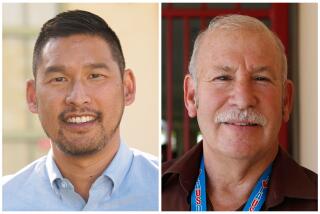L.A. Unified Seeks a Cure for Growing Pains
- Share via
The inscription, emblazoned in the conference room of a top Los Angeles school administrator, is a testament to 20 years of crisis-driven school construction.
“LAUSD, the ugly little building capital of the world,” it says, acknowledging a legion of prefabricated classrooms that mark the singular architectural statement of the Los Angeles Unified School District today.
In the decade to come, the district will have the opportunity to redeem itself, as it spends $3 billion in new school construction funds authorized by two bond measures.
But the launching of the largest school building spree since the 1950s has aroused the concern of business, cultural and community leaders who are skeptical that the giant bureaucracy can rise above the mentality that covered playgrounds with bungalows and built a high school on contaminated land.
They are mobilizing to forestall what they fear could become a civic disaster of more ugly buildings, bitter condemnation battles and voter disillusionment. Instead, they hope to shape a broad movement to beautify the city, bring communities together and design new facilities that serve as schools, libraries, parks and meeting halls all in one.
“We’re going to teach them how to do it,” said Westside businessman Steve Soboroff, a Los Angeles parks commissioner and chairman of the volunteer committee that oversees the Proposition BB bond spending. He is also one of the founders of New Schools Better Communities, which arose from the oversight committee’s frustrations and which organized the conference.
The teaching process began last week as dozens of school officials joined architects, community organizers, state and local officials and businesspeople on the spectacular grounds of the Getty Center in Brentwood.
Over two days of freewheeling talks, district officials laid themselves bare to sometimes harsh criticism, received heaps of friendly advice, and when it was over, reached out for help.
“It is my opinion we can’t do this all by ourselves,” said Lynn Roberts, head of the district’s bond construction program.
Soboroff quickly seized on the opening. He dashed off a letter Friday to Supt. Ruben Zacarias urging the district to hire a community consultant to take on the daunting task of finding land for 100 schools. At the same time, playing on a constant theme of the Getty conference, he suggested that if the district were to build smaller schools--as mounting educational research suggests it should--the number could rise to 150.
Zacarias endorsed the consultant idea, cautioning only that he doesn’t know yet how to pay for one.
“We just have to engage the community,” he said.
The session at the Getty strongly echoed a proposal floated earlier this year by state Sen. Tom Hayden (D-Los Angeles) to divest the district of the job of building schools, leaving it free to focus on its primary mission of education.
Zacarias signed on to the idea, but ran into opposition over Hayden’s initial suggestion that a state agency could take over the duty. Hayden has since said he envisions the creation of a local agency to do the work.
Without directly citing Hayden’s proposal, leaders of New Schools Better Communities appear to be stepping into that role.
The group includes a breadth of interests both public and private. Among them are Los Angeles Planning Director Con Howe, state Architect Fred Hummel, U.S. Environmental Protection Agency regional director Felicia Marcus, Getty President Barry Munitz and civil rights attorney Constance L. Rice.
Its members intend to continue meeting in work groups over the summer to draft a construction vision statement and implementation plan for a fall presentation to the district. Beyond that, they say, they will stick with it until the job is done.
“I hope one day we will look back on the last 20 years of school building and say with amazement, ‘Wow, that was a bad spell,’ ” said Michael Lehrer, president of the Los Angeles chapter of the American Institute of Architects and one of the founders of the group.
Judging by the ideas that emerged last week, the proposal unveiled next fall will be an ambitious plan to engage government agencies, private enterprise and nonprofit groups in a collaborative effort.
Other panelists spoke of combining city, county and community college services, incorporating medical care and day care into new schools and providing social centers for neighborhoods.
“We’re not building schools to keep the rain out,” said architect Steve Bengler, a consultant to the U.S. Department of Education. “We’re building schools to educate, to inspire.”
These flights of imagination were precipitated by a very down-to-earth circumstance: the crushing need for the district to pull out of its longest school construction drought in this century. In the two decades since Proposition 13 rolled back the property tax base, the Los Angeles district has managed to build only eight schools, fewer than in any decade since the 1890s. Meanwhile, enrollment has mushroomed to 700,000 students.
The financial obstacle to building schools has at last been removed. Proposition BB, approved by Los Angeles voters in 1997, has provided $900 million for the effort. An additional $1.8 billion is expected from last year’s statewide school bond measure, in all providing enough money to complete the district’s master plan for 51 new schools to end the busing of students away from overcrowded schools and to accommodate 70,000 new students anticipated by 2008.
Besides that, the district is expecting more than $300 million from a fund set aside for crowded campuses. With it the district hopes to build at least 40 additional elementary schools and primary centers, allowing the removal of bungalows from campuses that have lost too much playground area.
Even that ambitious building program would fall short of the 124 schools opened in the 1950s and the record 140 in the 1920s. But the obstacles today are more daunting than in earlier times, when school sites were set aside in new suburbs.
Today’s new schools must squeeze into overbuilt neighborhoods, setting up a choice between the purchase of abandoned industrial sites that are readily available but fraught with environmental problems (such as Belmont High School downtown), and the politically divisive process of condemning dwelling units.
The shortcomings of the district’s method for acquiring land were illustrated by a proposal to build a school near Cahuenga Elementary School in Hollywood, presented as a case study at the Getty conference.
Twelve hundred students attend the school at 3rd Street and Hobart Boulevard. An additional 1,400 catch buses outside it each day to ride to other schools from five to 60 minutes away.
Panelists concurred on the urgent need to construct new space for those students, but mercilessly picked apart the plan of Robert Niccum, head of the district’s real estate branch.
To minimize cost and disruption, Niccum avoided commercial properties in the area because businesses are hard to relocate. He avoided apartment buildings because the land is more expensive and more people must be relocated. This process of elimination finally led him to select two blocks of single-family homes across the street from the existing school, where he proposed to place another one of equal size.
Local resident George Richter protested that the targeted blocks are occupied by 19 Craftsman bungalows that have been nurtured by the neighborhood association for years.
Richter, president of the Beverly-Kingsley Neighborhood Group, said he would prefer three schools, not one. He proposed specific sites that he said would enhance the community and put the schools closer to the heaviest concentrations of students.
“It was a solution that no district employee could ever figure out,” Soboroff said later. “You have to live in the community. You have to get out in the community.”
(BEGIN TEXT OF INFOBOX / INFOGRAPHIC)
School Construction
Twice in this century, the Los Angeles Unified School District has had building booms to accommodate growing enrollment. After a 20-year drought, 100 new schools are planned in the next decade.
Source: Los Aangeles Unified School District
More to Read
Sign up for Essential California
The most important California stories and recommendations in your inbox every morning.
You may occasionally receive promotional content from the Los Angeles Times.











